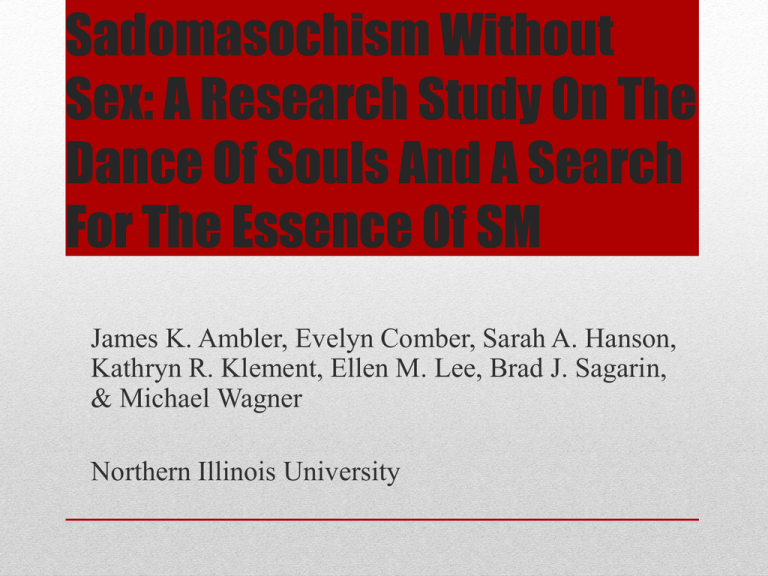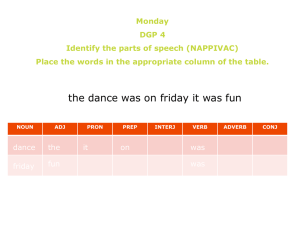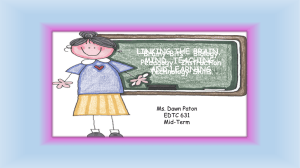
Sadomasochism Without
Sex: A Research Study On The
Dance Of Souls And A Search
For The Essence Of SM
James K. Ambler, Evelyn Comber, Sarah A. Hanson,
Kathryn R. Klement, Ellen M. Lee, Brad J. Sagarin,
& Michael Wagner
Northern Illinois University
Research Hypotheses
• Dance participants will consider the Dance as more
sadomasochistic than sexual.
• Dance participants will feel closer to others during the
Dance.
• Dance participants will experience an increase in positive
affect and a decrease in negative affect from before to
during the Dance.
• Dance participants’ hormonal levels will change during
the Dance.
Materials
• Surveys (before, during, after)
•
•
•
•
•
PANAS
Self/Other Overlap
We Relationship
Flow
Open-ended questions
• Why participate
• Expectations of Dance
• Saliva Samples
• Cognitive test (card-sorting task)
• Behavioral observations
Hypothesis Testing
• Hypothesis testing is used to determine the likelihood of there being
group differences
• Null hypothesis – no differences
• Alternate hypothesis - differences
• A p value represents the chance, given that the null hypothesis is true,
that you would obtain these results or results more extreme
• For example, a p = .03 means that 3% of the time, when there are no
group differences, we would obtain these results or results more extreme
• Another way of looking at this, when there are no group differences,
97% of the time we wouldn’t obtain results this extreme
• In psychology, we use a 5% cut-off (p = .05); this number is arbitrary but
represents what we consider to be acceptable risk
Correlation Coefficient
• The relationship between two standard variables
• They range from -1 to +1
-1=negative relationship
0=no relationship
+1=positive relationship
• Indicates a strength of a relationship (larger number indicates
stronger relationship)
• Just because there is a correlation between two variables does
not mean that one causes the other
• For example, the positive relationship between shark attacks and ice
cream sales
Types of Correlations
Perfect positive
correlation (+1.00)
Perfect negative
correlation (-1.00)
No relationship (0.00)
Participant Demographics
• Gender
• Males: 20, Females: 26, Transgender: 3
• Sexual Orientation
• Straight: 15, Gay: 8,
Heteroflexible: 9, Bisexual: 9, Other: 8
• BDSM Roles
• Top: 18, Bottom: 16, Switch: 14
• Age
• Mean: 49 years old, SD: 10.34 years
• Range: 23-71 years old
Gender Identity and
Sexual Orientation
16
14
12
10
Transgender
Female
Male
8
6
4
2
0
Straight
Gay
Heteroflex Bisexual
Other
Sexual Orientation and
BDSM Roles
16
14
12
10
Switch
Bottom
Top
8
6
4
2
0
Straight
Gay
Heteroflex
Bisexual
Other
Sexual vs. SM
Extremely 5
4.5
4
p =.09
3.5
3
How Sexual
2.5
2
1.5
Not at all
1
How SM
Sexual vs. SM vs. Spiritual
Extremely 5
p =.01
4.5
4
3.5
How Sexual
3
How SM
How Spiritual
2.5
2
1.5
Not at all 1
Correlations – Sexual, SM,
Spiritual
• Spiritual
• And pre self/other overlap = .527 (p = .01)
• And during self/other overlap = .423 ( p = .007)
• Sexual
• And pre positive affect = -.496 (p = .014)
• And pre sexual arousal = .487 (p = .016)
• And during sexual arousal = .758 (p = .001)
• SM
• And pre sexual arousal = .647 (p = .001)
• And during sexual arousal = .342 (p = .031)
Sexual Arousal
Extremely
5
4.5
4
p <.001
3.5
3
Sexual Arousal
2.5
2
1.5
Not at all
1
Before Dance
During Dance
Self/Other Overlap,
Relationship with Others
7
p = .85
6
p = .005
5
Before Dance
4
During Dance
3
2
1
"We" Relationship
Self/Other Overlap
Correlations –
Self/Other Overlap
• Pre self/other and during self/other = .463 (p = .026)
• Pre self/other and pre positive affect = .33 (p = .019)
PANAS
Extremely 50
p = .175
45
40
35
Pre-Dance
30
During-Dance
25
20
p = .014
15
Not at all 10
Positive Affect
Negative Affect
Correlations – Affect
•
•
•
•
Pre positive affect and during positive affect = .605 (p = .001)
Pre stressed and during negative affect = .502 (p = .003)
Pre negative affect and pre stressed = .743 (p = .001)
During stressed and during negative affect = .507 (p = .007)
Stressed
Extremely
5
4.5
4
3.5
p = .14
3
Stressed
2.5
2
1.5
Not at all
1
Pre-Dance
During-Dance
Cortisol
p = .064
0.5
0.45
0.4
0.35
0.3
0.25
Cortisol
0.2
0.15
0.1
0.05
0
Time 1
Time 2
SM Role x Sexual
How sexual was the Dance?
5
4.5
p = .036
p = .046
4
3.5
3
2.5
2
1.5
1
Top
Bottom
Switch
SM Role x Spiritual
How spiritual was the Dance?
5
p = .057
4.5
p = .031
4
3.5
3
2.5
2
1.5
1
Top
Bottom
Switch
Behavioral Observations
Time
Activity
1:30 pm
Before-care
2:00 pm
Sage burning
2:30 pm
Dance begins
5:45 pm
Drumming ends
6:10 pm
All lights back on
• The Dance lasted about 4 hours
• Biggest group of dancers hooked together observed = 8
• Not much verbal communication
• Dancers mostly communicated through eye contact and gestures
Pre-Dance Qualitative Data
• Why are you participating in the Dance of Souls?
What do you hope to get from the experience?
• “It is a wonderful way to exchange energy not just with my
owner but with my tribe. It is transcendental & amazing. It
is also a great way to release the negative.”
• “I find peace, power, and well-being at these events.”
• “To participate in high energetic levels and feel the
transformation that can occur in myself and others.”
• “I have had visions and deep spiritual experiences. Or not.
But it's fun anyway.”
During-Dance Qualitative Data
• Any current thoughts or feelings during the Dance
• “I am in an amazing happy place. Serene yet joyous.”
• “Connection through the drums and the tribe and the
shared energy that overrides any pain and -opens my
heart and mind to a focus beyond the physical.”
• “Just very high!!!”
• “Pleasantly exhausted”
• “I'm very happy and aroused. I feel strong and beautiful.”
Post-Dance Qualitative Data
• Please write down any thoughts or feelings:
• “All throughout the dance, I felt very present and connected
with everyone else there, but also recognized the work I was
doing was my own work and needed my attention. I also felt
closer to the spirits of those who have walked this earth before
us and the Universe's energy abuzz inside me. It was beautiful
and powerful.”
• “Observed energetic releases of others, saw emotions stir in
many; tears, anger, screaming, laughter, pure joy. Many had
variety of different experiences. I got to share in all of them,
and feel their release.”
Frequency of Qualitative Data Codes
29
23
21
17
16
15
14
12
12
8
7
6
4
3
3
2
2
Flow
• Are skills required for the Dance?
Major Conclusions
•
•
•
•
Mainly spiritual, less sexual or SM
Increase in connectedness to others
Reduction in negative affect
Higher body stress response, but reported reduction in
psychological stress
What’s happening?
This talk available at http://www.youtube.com/watch?v=syfalikXBLA
What’s happening?
29
23
21
17
16
15
14
12
12
8
7
6
4
3
3
2
2
Common experiences of altered states of consciousness:
• time distortions
• disinhibition from social constraints
• changes in focused attention
Transient Hypofrontality States
-Runner’s High
-Meditation
-Dreaming
-Day dreaming
-Hypnosis
-Various Drug Highs
Specific variations:
• reduction of pain
• feelings of floating
• feelings of peacefulness
• little consistent logic
• difficulty with memory
• feeling of living in the
here and now
• little active decision
making
Dietrich (2003)
•
•
“The human brain has limited resources”
•
Specific structures receive more blood flow
“A minimum level of intensity is required to force the
redistribution of resources in the brain.”
Dietrich (2003)
Dorsolateral prefrontal cortex (DL):
• Important for directed attention,
temporal integration, and working
memory
Working memory deficits cause:
•
•
•
•
Less abstract thinking
Less access to memory
Less self-reflective consciousness
Less cognitive flexibility
These lead to subjective changes
in consciousness
Dietrich (2003)
• Motivational; the self is sometimes burdensome
• “Pain gradually obliterates psychological content, eventually leaving only
the awareness of pain. One’s knowledge of the world is temporarily
forgotten, and attention is narrowed to the immediate present, both
spatially and temporally.” (Scarry, 1985)
• Pain, interrupted action and failure feedback focus people’s attention
• BDSM play
•
•
•
•
Pain
Bondage
Humiliation
Sex as a reinforcer
Baumeister (1988)
Vallacher & Wegner (1987, 1989)
Tentative Support?
• Transient Hypofrontality
•
•
•
•
•
•
Feelings of oneness with others, with the universe
Feelings of transcendence
Feelings of peacefulness
Spirituality, connectedness, altered consciousness
Rating the Dance as more spiritual than sexual or SM
Increase in ratings of self/other overlap
• Escape from Self
• Reduction in negative affect
• Increase in physiological stress, decrease in psychological
stress
In Conclusion…
• Problems?
• Cognitive testing: transient nature, appropriateness of task
• N size
• This study was not a direct test of these theories
• We can only interpret results cautiously
• The context and framing elements of the conference may
influence the way participants perceived the Dance
• This is why we need to continue doing research!
• Switch Study at APEX – March 29
THANK YOU!









